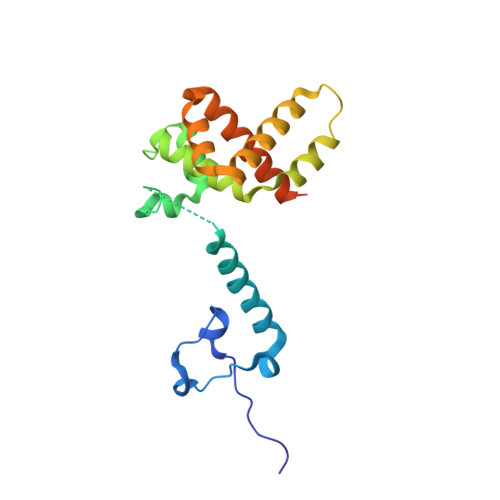Crystal Structure of the Essential Transcription Antiterminator M2-1 Protein of Human Respiratory Syncytial Virus and Implications of its Phosphorylation.
Tanner, S.J., Ariza, A., Richard, C., Kyle, H.F., Dods, R.L., Blondot, M., Wu, W., Trincao, J., Trinh, C.H., Hiscox, J.A., Carroll, M.W., Silman, N.J., Eleouet, J., Edwards, T.A., Barr, J.N.(2014) Proc Natl Acad Sci U S A 111: 1580
- PubMed: 24434552
- DOI: https://doi.org/10.1073/pnas.1317262111
- Primary Citation of Related Structures:
4C3B, 4C3D, 4C3E - PubMed Abstract:
The M2-1 protein of the important pathogen human respiratory syncytial virus is a zinc-binding transcription antiterminator that is essential for viral gene expression. We present the crystal structure of full-length M2-1 protein in its native tetrameric form at a resolution of 2.5 Å. The structure reveals that M2-1 forms a disk-like assembly with tetramerization driven by a long helix forming a four-helix bundle at its center, further stabilized by contact between the zinc-binding domain and adjacent protomers. The tetramerization helix is linked to a core domain responsible for RNA binding activity by a flexible region on which lie two functionally critical serine residues that are phosphorylated during infection. The crystal structure of a phosphomimetic M2-1 variant revealed altered charge density surrounding this flexible region although its position was unaffected. Structure-guided mutagenesis identified residues that contributed to RNA binding and antitermination activity, revealing a strong correlation between these two activities, and further defining the role of phosphorylation in M2-1 antitermination activity. The data we present here identify surfaces critical for M2-1 function that may be targeted by antiviral compounds.
- Astbury Centre for Structural Molecular Biology and School of Molecular and Cellular Biology, University of Leeds, Leeds LS2 9JT, United Kingdom.
Organizational Affiliation:

















